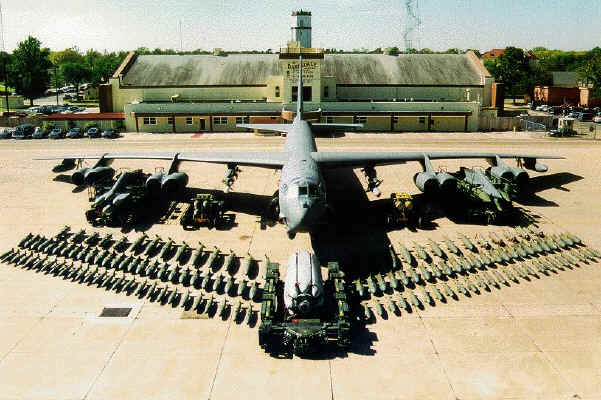 |
|
|||
|
|
||||
B-52 Strato-fortress, The Buffs |
|
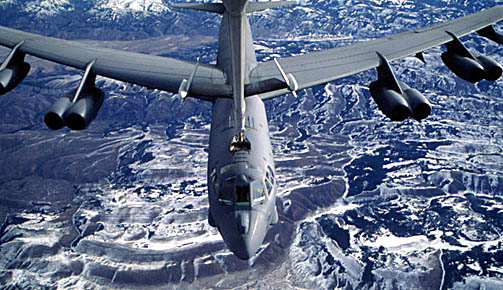
|
In June 1965, B-52s entered combat when they began flying missions in Southeast Asia. |
|
By Aug. 1973, they had flown 126,615 combat sorties with 17 B-52s lost to enemy action. |
|
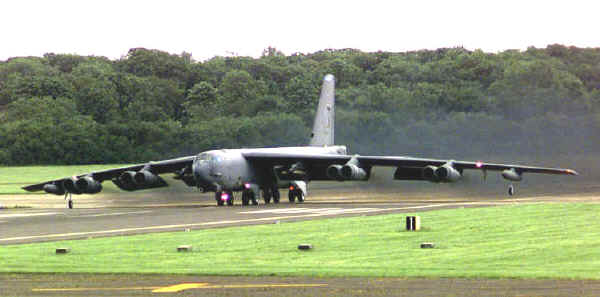
|
| The B-52 D/F long range bombers
were designed
to carry nuclear weapons but some were reconfigured and used in the
VIETNAM war to drop "Iron Bombs". Their normal bomb load was 84
bombs internally and 24 bombs under the wings. Each bomb weighed 500
pounds. (Sometimes they carried 750 lb bombs.) That's 54,000 pounds of HE,
a lot of bang from each aircraft.
Crews and aircraft from the 22nd, 91st, 99th, 306th, 454th, and 461st Bomb Wings rotated through the bombing campaign. Flying out of Andersen Air Force Base on Guam Island (and later U-Tapao Base in Thailand) they had sufficient range to drop their loads on VIETNAM and return without stopping. However to increase their bomb load they normally took off with less than full fuel tanks and refuelled in mid-air west of Luzon. These aircraft worked in threes (called cells) and their attacks were called "Arc Lights". The bombs punched 50 ft holes in the ground and cleared away a lot of jungle. They did not, however, kill great numbers of NVA. Often warned by Russian "Trawlers" sailing near Guam and using state of the art radio intercept equipment, the NVA forces frequently moved out of the target area shortly before the bombs arrived. |
 |
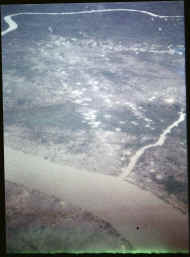 |
|
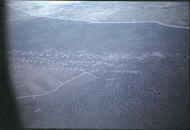 |
MissionAir Combat Command's B-52 is a long-range, heavy bomber that can perform a variety of missions. The bomber is capable of flying at high subsonic speeds at altitudes up to 50,000 feet (15,166.6 meters). It can carry nuclear or precision guided conventional ordnance with worldwide precision navigation capability. FeaturesIn a conventional conflict, the B-52 can perform strategic attack, air interdiction, offensive counter-air and maritime operations. During Desert Storm, B-52s delivered 40 percent of all the weapons dropped by coalition forces. It is highly effective when used for ocean surveillance, and can assist the U.S. Navy in anti-ship and mine-laying operations. Two B-52s, in two hours, can monitor 140,000 square miles (364,000 square kilometres) of ocean surface. All B-52s are equipped with an electro-optical viewing system that uses platinum silicide forward-looking infrared and high resolution low-light-level television sensors to augment targeting, battle assessment, and flight safety, thus further improving its combat ability and low-level flight capability. Pilots wear night vision goggles (NVGs) to enhance their vision during night operations. Night vision goggles provide greater safety during night operations by increasing the pilot's ability to visually clear terrain, avoid enemy radar and see other aircraft in a covert/lights-out environment. Starting in 1989, on-going modifications incorporates the global positioning system, heavy stores adapter beams for carrying 2,000 pound munitions, and a full array of advance weapons currently under development. The use of aerial refuelling gives the B-52 a range limited only by crew endurance. It has an un-refuelled combat range in excess of 8,800 miles (14,080 kilometres). The aircraft's flexibility was evident in Operation Desert Storm and again during Operations Allied Force. B-52s struck wide-area troop concentrations, fixed installations and bunkers, and decimated the morale of Iraq's Republican Guard. The Gulf War involved the longest strike mission in the history of aerial warfare when B-52s took off from Barksdale Air Force Base, La., launched conventional air launched cruise missiles and returned to Barksdale -- a 35-hour, non-stop combat mission. During Operation Allied Force, B-52s opened the conflict with conventional cruise missile attacks and then transitioned to delivering general purpose bombs and cluster bomb units on Serbian army positions and staging areas. BackgroundFor more than 40 years B-52 Stratofortresses have been the backbone of the manned strategic bomber force for the United States. The B-52 is capable of dropping or launching the widest array of weapons in the U.S. inventory. This includes gravity bombs, cluster bombs, precision guided missiles and joint direct attack munitions. Updated with modern technology the B-52 will be capable of delivering the full complement of joint developed weapons and will continue into the 21st century as an important element of our nation's defences. Current engineering analyses show the B-52's life span to extend beyond the year 2045. The B-52A first flew in 1954, and the B model entered service in 1955. A total of 744 B-52s were built with the last, a B-52H, delivered in October 1962. Only the H model is still in the Air Force inventory and is assigned to Air Combat Command and the Air Force Reserves. The first of 102 B-52H's was delivered to Strategic Air Command in May 1961. The H model can carry up to 20 air launched cruise missiles. In addition, it can carry the conventional cruise missile that was launched in several contingencies during the 1990s, starting with Operation Desert Storm and culminating with Operation Allied Force. General CharacteristicsPrimary
Function: Heavy bomber |
